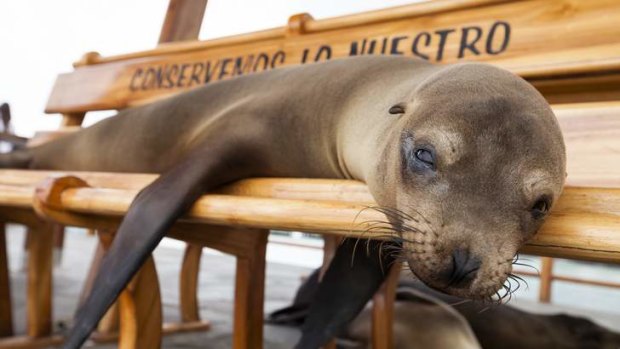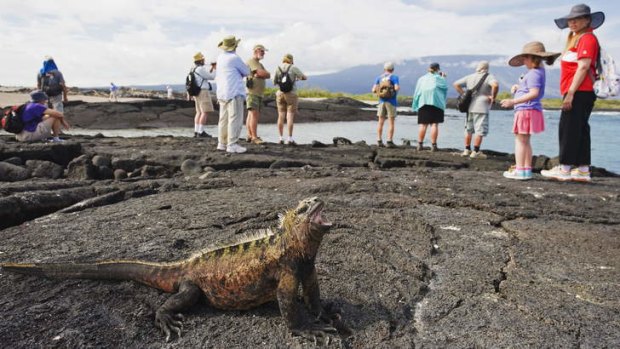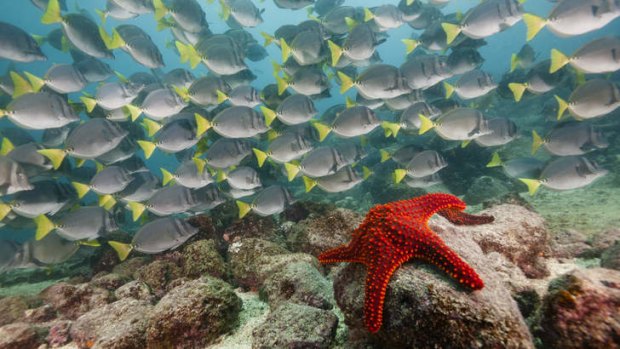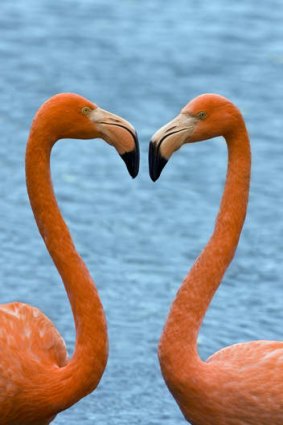
A young fur seal on San Christobal Island.Credit: Corbis
Animals dictate Galapagos life, writes Andrew Bain.
In the Galapagos Islands town of Puerto Ayora, a hungry crowd surrounds the fish market. As fishermen gut their catches, a ring of Galapagos sea lions and brown pelicans awaits the scraps. Nearby, marine iguanas shelter in the shade of a playground, outnumbering the children. Mockingbirds hop about the street, and blue herons patrol the shores.
They are scenes that speak volumes about these legendary islands, 1000 kilometres off South America's Pacific coast. Anywhere else in the world, Puerto Ayora would be a wildlife destination in its own right, but in the Galapagos it's the equivalent of a metropolis.

A marine iguana, Isla Isabela.Credit: Corbis
Home to 18,000 people and umpteen thousand animals, the Galapagos' largest town is symbolic of an archipelago where, uniquely, people seem to exist almost entirely on nature's terms.
In Puerto Ayora, humans are just another animal. They are also unexpected. Though the world knows of the Galapagos' animals, few know of its people. The archipelago comprises 17 main islands - each one the tip of an underwater volcano - and is home to around 30,000 people, sprinkled across four towns on four islands. They are the minority, with the national park covering 97 per cent of the islands, and human settlement squeezed into just 3 per cent of the land.
A perfect snapshot of this symbiosis is the small town of Puerto Villamil at the southern end of Isla Isabela, where I wake aboard the Queen Beatriz catamaran - my transport and home for the next week - on my first morning in the Galapagos. Straddling the equator, seahorse-shaped Isabela is the largest of the Galapagos Islands, representing almost two-thirds of the archipelago's land mass.

Red starfish and yellowtail surgeonfish.Credit: Getty Images
Effectively a chain of six volcanoes, its southern end forms the world's second-largest caldera (after Yellowstone), enclosing Puerto Villamil, a huddle of buildings along a palm-lined beach with around 2000 residents. Road signs caution of iguanas crossing, and salmon-coloured flamingos brighten a flooded gravel pit at the edge of town.
Reaching out from the town are natural breakwaters and islands of mangrove-covered basalt, and it's on one of these tiny islands that you will find Tintoreras, one of the 116 set visitor sites in the Galapagos.
At a glance, Tintoreras looks as barren as the majority of the Galapagos - black, parched, inhospitable - a scene at odds with the islands' reputation as a cradle of life.

Shape-making flamingos.Credit: Corbis
Years before he famously published On the Origin of Species, the archipelago's most famous visitor, Charles Darwin, described a typical Galapagos island in rather unbecoming terms.
"Nothing could be less inviting than the first appearance," he wrote in Voyage of the Beagle.
"A broken field of black basaltic lava . . . is everywhere covered by stunted, sun-burnt brushwood which shows little sign of life."
Tintoreras, like so much of the archipelago, defies appearance. Across its sharp black rocks, marine iguanas have created an enormous nursery, and when I step ashore, the ground seems almost to move as thousands of juvenile iguanas part from the walking path. Stop for a moment, and the smallest of the iguanas wander up to my feet in curiosity.
Below, in a narrow channel of water, a dozen white-tipped reef sharks swim lazy circles. Sally Lightfoot crabs, as red as lipstick, line the shores, and sea turtles surface like croutons in the lagoon behind. Galapagos sea lions recline on a coral-rubble beach, as blue-footed boobies spear into the sea for breakfast, hitting the water at up to 100 km/h. It's a virtual pop-up book of Galapagos animal life, and all inside a radius of just a few hundred metres.
As we wander around Tintoreras, other groups follow us ashore, as they do in ever-growing numbers in the Galapagos. In 2011, 185,000 people visited the islands, more than double the number from just eight years before.
In an attempt to slow the tourism boom, national park admission fees were doubled - to $US100 ($106.50) - in 2009, though visitor numbers still increased by 13 per cent in the following two years. Around the islands, there's now talk that the fee may double again, creating a more exclusive and elite experience - higher fees, lower volume - to protect the fragile environment. The shift towards exclusivity is already being reflected in the quality of Galapagos cruise ships, including the Queen Beatriz.
Owned by three Galapagan brothers, who named the ship after their mother, it's one of the few locally owned tourist boats in the archipelago, and features an outdoor deck spa, two bars, 16 berths, and living spaces over three levels. All food, including the coffee, is sourced organically from the Galapagan highlands.
"The three brothers started with a very small boat and worked up to this," says my guide, Juan Carlos, who in six years as a Galapagos guide has watched the 100-plus ships working the islands evolve faster than the wildlife.
Aboard the Queen Beatriz, there are afternoons in which we simply sail, leapfrogging through the archipelago. Even as we skim across the ocean, there are random wildlife treats.
Dolphins play in the bow wave, manta rays leap from the sea, and the shapes of sea turtles are imprinted on the ocean's surface. When we stop to snorkel one day, a sea lion boards the ship for a nap.
Other times we sail through the night, conjured to a different island as we sleep, drifting west through the archipelago. Each day there are excursions ashore, and each day I'm tempted to think I've found the island with the Galapagos' greatest concentration of wildlife. Until the next day and the next island.
Even the ocean competes to be the Galapagos' finest wildlife destination. Don a snorkel and mask almost anywhere, and it's like plunging into an outtake from Finding Nemo. The ocean floor is a marine constellation of sea stars and sun corals, and shoals of colourful fish - parrotfish, yellow-tailed surgeonfish, king angelfish - waft around me. Diamond stingrays stir up sandstorms on the seabed, and sea turtles glide past by the dozen.
In the deep channel of water that splits 130-metre-high Kicker Rock, off the coast of Isla San Cristobal, reef sharks and Galapagos sharks - menacing in shape but not in intent - rise out of the abyss, stopping just metres from me, before disappearing again.
But it's the Galapagos sea lions that come to be the stars of the ocean. Swim almost anywhere and sea lions materialise, their liquid eyes looking as playful as their movements. Dive down and they dive with me, turning cartwheels, spinning and twirling, seemingly as interested in me as I am in them.
Sea lions are also the stars of Isla San Cristobal where, in the town of Puerto Baquerizo Moreno, the archipelago's political centre, I step ashore on a Galapagos island for the final time.
Billing itself as the "Capital of Paradise", Puerto Baquerizo Moreno is a likeable town, its colourful homes sprinkled through the green bush like confetti.
From the town pier, where we disembark, I wander along the esplanade, looking over an armada of fishing and tourist boats.
Every bench along the esplanade is sprawled with bodies - sea lions - with barely a seat remaining among the dozens of animals that lounge in the sun, oblivious to the residents, visitors and vehicles around them.
Those sea lions that can't fit on the benches cover the footpath, the shoreline rocks and the beach. Marine iguanas wander about.
As I walk, I'm forced to step around the animals, ceding the path to them. This may be the second largest town in the Galapagos Islands, but it's clear that the animal kingdom is still king here.
The writer travelled courtesy of Peregrine Adventures.
TRIP NOTES
MORE INFORMATION
GETTING THERE
Lan Airlines' fares to Quito from $2500 low-season return from Sydney and Melbourne. Sydney passengers fly to Santiago, then to Guayaquil and to Quito; see lan.com. From Quito, Aerogal flies to the islands (from $470) via Guayaquil; see aerogal.com.ec.
TOURING THERE
Peregrine Adventures operates a selection of trips through the Galapagos Islands aboard the Queen Beatriz. The trip described in this article is the 10-day Classic Galapagos Itinerary A ($4885); see peregrineadventures.com.
Sign up for the Traveller Deals newsletter
Get exclusive travel deals delivered straight to your inbox. Sign up now.